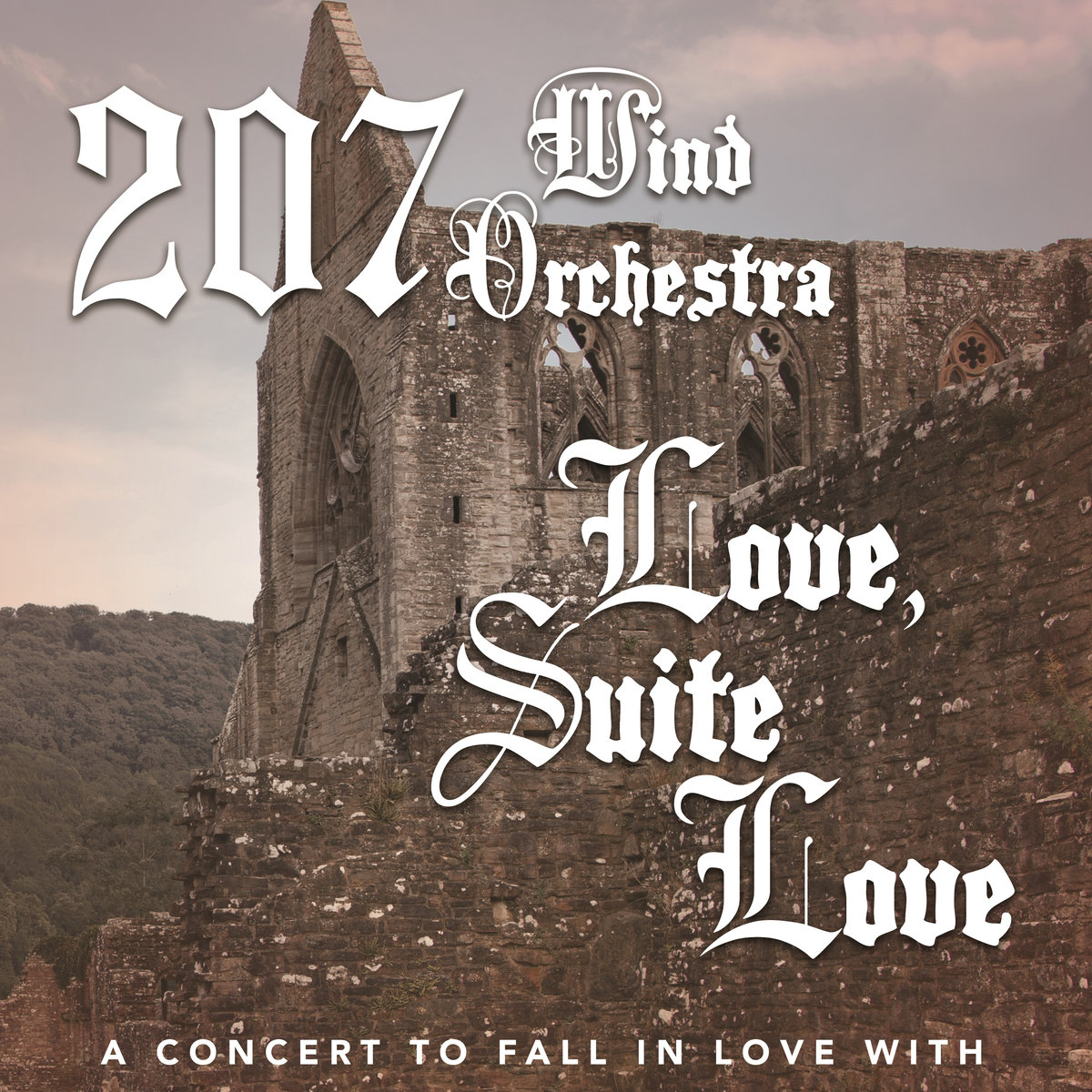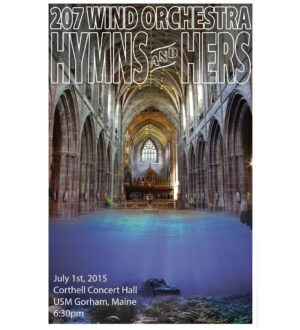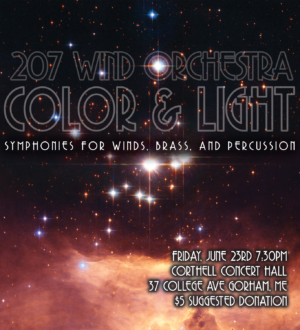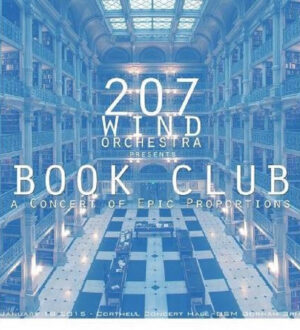Description
Recorded live February 13, 2016 Portland High School Auditorium Timothy Burns, conductor Bill Putnam, recording engineer Nathan Galvez, cover art Gavorkna Fanfare, Jack Stamp (b. 1954) Medieval Suite, Ron Nelson (b. 1929) Homage to Leonin Homage to Perotin Homage to Machaut all stars are love, Steven Bryant (b. 1972) First Suite in E-Flat, Gustav Holst (1874 - 1934) Chaconne Intermezzo March Second Suite in F, Gustav Holst (1874 - 1934) March Song Without Words, “I’ll Love My Love” Song of the Blacksmith Fantasia on the “Dargason” Riften Wed, Julie Giroux (b. 1961) Lincolnshire Posy, Percy Aldridge Grainger (1882 - 1961), ed. Frederick Fennell Lisbon (Sailor’s Song) Horkstow Grange (The Miser and his Man: A local Tragedy) Rufford Park Poachers (Poaching Song) The brisk young Sailor (returned to wed his True Love) Lord Melbourne (War Song) The Lost Lady Found (Dance Song)
Gavorkna Fanfare was composed for and dedicated to Eugene Corporon and the University of Cincinnati College – Conservatory of Music Wind Symphony.
The work exploits the idea of a fanfare for full wind band, rather than the traditional brass and percussion instrumentation. The opening pyramids lead to the melodic minor third cluster heard in original and inversion simultaneously. A polychordal transition based on the upcoming “fugato” subject leads to a minimalist accompaniment to the four-part counterpoint. The opening idea returns with a coda based on the melodic minor third.
I wish I had never named this work Gavorkna. I constantly receive calls inquiring as to the meaning of the title. It is a made-up word and a joke between Eugene Corporon and myself.
Gene called me in October 1999 stating that his Cincinnati College Conservatory Wind Symphony would be performing at the College Band Directors National Association Conference in Kansas City in February. He asked me to suggest an opener. I said, “Let me write you one. If you like it, you can have it for free. If you don’t I won’t be upset.” I wrote the piece in two days. I scored it and sent it to Gene. He called and said, “You can ignore me completely, but the fugue is boring.” I said, “How can a four-part fugue be boring?” But he was right! So, on Christmas Eve, I re-wrote the fugue by ornamenting each entrance. It made the work much stronger. To date, this is my most popular work and has launched some of the earlier works as well as provided numerous commissions. I owe Gene a lot, both as my teacher of conducting, and as a friend.
-Jack Stamp
Dr. Jack Stamp (born 1954) is Professor of Music and Director of Band Studies at Indiana University of Pennsylvania (IUP), where he conducts the Wind Ensemble and Symphony Band and teaches courses in undergraduate and graduate conducting. Dr. Stamp received his Bachelor of Science in Music Education Degree from IUP, a Master’s in Percussion Performance from East Carolina University (ECU), and a Doctor of Musical Arts Degree in Conducting from Michigan State University, where he studied with Eugene Corporon.
Prior to his appointment at IUP, he served as chairman of the Division of Fine Arts at Campbell University in North Carolina. He also taught for several years in the public schools of North Carolina. In addition to these posts, Dr. Stamp served as conductor of the Duke University Wind Symphony (1988-89) and was musical director of the Triangle British Brass Band, leading them to a national brass band championship in 1989.
Dr. Stamp’s primary composition teachers have been Robert Washburn and Fisher Tull, though he was strongly influenced by his music theory teachers at IUP and ECU. Recent studies include work with noted American composers David Diamond, Joan Tower, and Richard Danielpour.
He is active as a guest conductor, clinician, adjudicator, and composer throughout North America and Great Britain. His compositions have been commissioned and performed by leading military and university bands across the United States. He has won the praise of American composers David Diamond, Norman Dello Joio, Michael Torke, Samuel Adler, Robert Ward, Robert Washburn, Fisher Tull, Nancy Galbraith and Bruce Yurko for performances of their works. He is also a contributing author to the “Teaching Music Through Performance in Band” series.
In 1996, he received the Orpheus Award from the Zeta Tau Chapter of Phi Mu Alpha for service to music and was named a Distinguished Alumnus of Indiana University of Pennsylvania. In 1999, he received the Citation of Excellence from the Pennsylvania Music Educators Association. In 2000, he was inducted into the prestigious American Bandmasters Association.
Medieval Suite was written in homage to three great masters of the Middle Ages: Leonin (middle 12th century), Perotin (c. 1155- 1200), and Machaut (c. 1300-1377). These are neither transcriptions of their works nor attempts at emulating their respective styles. Rather, the music served as a sort of launching pad for three pieces which draw on some of the stylistic characteristics of music from that period, e.g., repetition of rhythmic patterns or modes, modules of sound, proportions that produce octaves, fourths and fifths, use of Gregorian chant, syncopation, long pedal points where a sustained tone regulates melodic progression.
Homage to Leonin evokes his sinuous melodic style and use of Gregorian chant. It is a “mood piece” in which a chant on the Dorian mode is gradually transformed into a perfectly symmetrical eight-tone scale. The movement follows the form of an arch with a large climax, after which it closes as it began.
Homage to Perotin springs from his Viderunt – with its driving rhythmic intensity, repetition, and pedal points. The opening section features insistent dissonances in alternation with brass fanfare-like passages. A second theme played by unison brass is written in the Aeolian mode.
Wikipedia provides a helpful summary of the importance of this particular chant:
“Viderunt Omnes is based on an ancient gradual of the same title. The chant was subsequently expanded upon by composers of the Notre Dame school who developed it as type of early polyphony known as organum. Thought to be written for Christmas, the polyphonic settings would have retained the same liturgical purpose as the original gradual, while being musically enhanced for the festivities. The cantus firmus, or tenor, “holds” the original chant, while the other parts develop complex melismas on the vowels. The various settings of Viderunt Omnes provide context for specific trends in medieval music.
…Perotin’s four-part version of Viderunt, one of the few existing examples of Organum Quadruplum, may have been written for the Feast of the Circumcision in 1198. We know that at this time Eudes de Sully, bishop of Paris, was promoting the use of polyphony.
Whatever the original context may have been, Nelson brings the chant into a new era in a deft celebration of the marriage of compositional craft and emotional effusion.
Homage to Machaut evokes the stately, gently syncopated and flowing sounds of this master of choral writing. The movement consists of a statement with two repetitions, each with different instrumentation. It closes with the same chant and instrumental textures which opened the suite.
Medieval Suite was first performed March 18, 1983 at the National Conference of the College Band Directors National Association by the Western Michigan University Symphonic Band, Richard J. Suddendorf, conductor.
-Ron Nelson
Ron Nelson (born 14 December 1929 in Joliet, Illinois) is an American composer. He received his bachelor of music degree in 1952, the master’s degree in 1953, and the doctor of musical arts degree in 1956, all from the Eastman School of Music at the University of Rochester. He also studied in France at the Ecole Normale de Musique and at the Paris Conservatory under a Fulbright Grant in 1955. Dr. Nelson joined the Brown University faculty the following year, and taught there until his retirement in 1993.
In 1991, Dr. Nelson was awarded the Acuff Chair of Excellence in the Creative Arts, the first musician to hold the chair. In 1993, his Passacaglia (Homage on B-A-C-H) made history by winning all three major wind band compositions – the National Association Prize, the American Bandmasters Association Ostwald Prize, and the Sudler International Prize. He was awarded the Medal of Honor of the John Philip Sousa Foundation in Washington, DC in 1994. In 2006, he was awarded an honorary doctorate from Oklahoma City University.
Dr. Nelson has received numerous commissions, including those from the National Symphony Orchestra, Rochester Philharmonic, the USAF Band and Chorus, Rhode Island Philharmonic, Aspen Music Festival, Brevard Music Center, Musashino Wind Ensemble, and countless colleges and universities. He has also received grants and awards from The Rockefeller Foundation, the Howard Foundation, ASCAP, and several from the National Endowment for the Arts. He has also appeared as guest composer/conductor at a large number of colleges and universities, including Illinois, Yale, North Texas State, Western Michigan, Sam Houston, Lawrence, Dartmouth, Southern Maine, CalTech, MIT, and Princeton.
all stars are love began as a simple song written as a surprise gift for my wife, Verena, for our wedding in 2010. I set the E.E. Cummings poem all stars are (and not one star only) love, and our dear friend and extraordinary soprano Hila Plitmann performed it at the ceremony in Austria. Fellow composer (and Hila’s husband!) Eric Whitacre suggested at the time that it would work well as an instrumental work, and that thought stuck with me, until the right opportunity to adapt the work arose. This commission from the Colorado Wind Ensemble and CWE Commissioning Project Consortium gave me that opportunity. I can never simply arrange a work from one medium to another, however, and I ended up recomposing large portions of the work, so this is as much new music as it is material from the original song, though the dramatic shape and harmonic progression at the heart of the work remain.
-Steven Bryant
all stars are(and not one star only)love
-but if a day climbs from the mountain of
myself,each bird alive will sing for joy
in some no longer darkness who am i
-e.e. cummings
Steven Bryant (born 1972 in Little Rock, Arkansas) is an active composer and conductor with a varied catalog, including works for wind ensemble, orchestra, electronic and electro-acoustic creations, chamber music, and music for the web.
Steven trained for one summer in the mid-1980s as a break-dancer, was the 1987 1/10 scale radio-controlled car racing Arkansas state champion, and has a Bacon Number of 1. He is also Distinguished Visiting Professor of Composition at the University of North Carolina Greensboro for the 2014-2015 academic year. Steven studied composition with John Corigliano at The Juilliard School, Cindy McTee at the University of North Texas, and Francis McBeth at Ouachita University, He resides in Durham, NC with his wife, conductor Verena Moesenbichler-Bryant.
Now considered one of the masterworks and cornerstones of the band literature, First Suite in E-Flat was composed in 1909. Although completed in 1909, the suite didn’t receive its official premiere until 11 years later on June 23rd, 1920, by an ensemble of 165 musicians at the Royal Military School of Music at Kneller Hall. However, the work was originally conceived to be performed by ensembles significantly smaller than the one at Kneller Hall. During this time period there was no standardized instrumentation among the hundreds of British military bands of the day, and as a result no significant literature had been previously written for the band medium; most British bands up to then performed arrangements of popular orchestral pieces. In order to ensure the suite would be accessible to as many bands as possible, Holst ingeniously scored the work so that it could be played by a minimum of 19 musicians, with 16 additional parts that could be added or removed without compromising the integrity of the work.
There are three movements in the suite: Chaconne, Intermezzo, and March. Holst writes, “As each movement is founded on the same phrase, it is requested that the suite be played right through without a break.” Indeed, the first three notes of the Chaconne are E-flat, F and C, and the first three notes of the melody when it first appears in the Intermezzo are E-flat, F, and C. In the third movement, March, Holst inverts the motive: the first note heard in the brilliant opening brass medley is an E-flat, but instead of rising, it descends to a D, and then a G; the exact opposite of the first two movements.
The Chaconne begins with a ground bass reminiscent of those written by Henry Purcell or William Byrd. It is performed by tuba, euphonium and string bass and is repeated throughout the ensemble sixteen full times as varying instrumental textures and variations of the theme are layered within it. Following a delicately scored chamber setting of the theme, the music steadily builds to a brilliant E-flat Major chord that concludes the movement.
The Intermezzo is light and brisk and features soloistic passages for the cornet, oboe and clarinet. Holst prominently displays the agility and sensitivity of the wind band through transparent textures and passages where the melody and accompaniment are woven into a variety of instrumental settings.
The March begins suddenly. It consists of two themes, the first of which, performed by brass choir and percussion, is a march light in character. The second theme is dominated by the woodwinds and is composed of a long, lyrical line reminiscent of the original Chaconne melody. The movement concludes with both themes intertwining as the band crescendos to a climax.
-Esmail Khalili
The Second Suite in F consists of four movements, all based on specific English folk songs.
The March of the Second Suite begins with a simple five note motif between the low and high instruments of the band. The first folk tune is heard in the form of a traditional British brass band march using the morris-dance tune Glorishears. After a brief climax, the second strain begins with a euphonium solo playing the second folk tune in the suite Swansea Town. The theme is repeated by the full band before the trio. For the trio, Holst modulates to the unconventional sub-dominant minor of B-flat minor and changes the time signature to 6/8, thereby changing the meter. (Usually one would modulate to the sub-dominant major in traditional march form. While Sousa, reputably the “king of marches”, would sometimes change time signatures for the trio (most notably in “El Capitan”), it was not commonplace.) The third theme, called Claudy Banks, is heard in a low woodwind soli, as is standard march orchestration. Then the first strain is repeated da capo.
Holst places the fourth folk song, I’ll Love My Love in stark contrast to the first movement. The movement begins with a chord from french horns and moves into a solo of clarinet with oboe over a flowing accompaniment in F Dorian. The solo is then repeated by trumpet, forming an arc of intensity. The climax of the piece is a fermata in measure 32, followed by a trumpet pickup into the final measures of the piece.
In Song of the Blacksmith, Holst again contrasts the slow second movement to the rather upbeat third movement which features the folk song A Blacksmith Courted Me. The brass section plays in a pointillistic style depicting a later Holst style. There are many time signature changes (4/4 to 3/4) making the movement increasingly difficult because the brass section has all of their accompaniment on the up-beats of each measure. The upper-woodwinds and horns join on the melody around the body of the piece, and are accompanied with the sound of a blacksmith tempering metal with an anvil called for in the score. The final D major chord has a glorious, heavenly sound, which opens way to the final movement. This chord works so effectively perhaps because it is unexpected: the entire movement is in F major when the music suddenly moves to the major of the relative minor.
The final movement, Fantasia on the Dargason is not based on any folk songs, but rather has two tunes from Playford’s Dancing Master of 1651. The finale of the suite opens with an alto saxophone solo based on the folk tune Dargason, a 16th Century English dance tune included in the first edition of The Dancing Master. The fantasia continues through several variations encompassing the full capabilities of the band. The final folk tune, Greensleeves, is cleverly woven into the fantasia by the use of hemiolas, with Dargason being in 6/8 and Greensleeves being in 3/4. At the climax of the movement, the two competing themes are placed in competing sections. As the movement dies down, a tuba and piccolo duet forms a call back to the beginning of the suite with the competition of low and high registers.
The name “dargason” may perhaps come from an Irish legend that tells of a monster resembling a large bear (although much of the description of the creature has been lost over time), the Dargason tormented the Irish country side. During the Irish uprising of the late 18th Century, the dargason is supposed to have attacked a British camp killing many soldiers. This tale aside, “dargason” is more likely derived from from an Anglo-Saxon word for dwarf or fairy, and the tune has been considered English (or Welsh) since at least the 16th Century. It is also known as “Sedony” (or Sedany) or “Welsh Sedony”.
Holst later rewrote and re-scored this movement for string orchestra, as the final movement of his St Paul’s Suite (1912), which he wrote for his music students at St Paul’s Girls’ School.
-Imogen Holst
Gustav Holst (born 21 September 1874, in Gloucestershire, UK, died 25 May 1934, in London) was a British composer and educator. He learned piano at an early age, but was stricken with a nerve condition that affected the movement of his right hand, forcing him to give up the piano for the trombone.
He received his degrees from The Royal College of Music in London, where he met fellow composer (and lifelong friend) Ralph Vaughan Williams and became interested in Hindu mysticism and spirituality, interests that would later shape the course of his compositional output. In 1901 Holst married Isobel Harrison, who would remain with him the remainder of his life.
Before Holst became a well-known composer, he relied on income from playing the trombone in the Carl Rosa Opera Company and in the White Viennese Band, a popular orchestra specializing in “light music.” In 1905,Holst became Director of Music at the St Paul’s Girls’ School in Hammersmith, London, and in 1907, he also became director of music at Morley College, retaining both positions until his death in 1934. Holst’s compositions for wind band, although only a small portion of his total output, have made him a cornerstone of the genre.
Riften Wed was composed for Dennis W. Fisher and the University of North Texas Symphonic Band.
Riften is a city in Skyrim located in the expansive world of Elder Scrolls, the fifth installment of an action role-playing video game saga developed by Bethesda Game Studios and published by Bethesda Softworks. Skyrim is an open world game that by any video game standard is geographically massive and more closely related to an online mmorpg (massive multiplayer online role-playing game) than to its console and pc competition.
Skyrim is a beautiful world, from mountainous snowy regions to open tundra plains, sea coasts, beaches, thick woods, lakes and hot spring-fed swamps. Large cities, villages, forts, ancient ruins, caves, lone houses, sawmills and abandoned shacks dot the atlas. One can spend hours just walking or riding horseback from one side of the continent to the other doing nothing but experiencing its wondrous environment and lore. It is truly a game worthy of total immersion. Oh, and I should mention that it is also a deadly world, torn apart by civil war and dragons who have resurfaced after thousands of years, not to mention the cult of vampires that are also threatening to take over the world.
Riften is a seedy, crime-filled and nearly lawless city. Located on a waterfront with skooma-addicted dock workers and corrupt guards, it also boasts the headquarters of the Thieve’s Guild. Sadly enough, it is also the location for the world’s orphanage and the Temple of Mara, the place where the good citizens of Skyrim have to go to get married, you included.
Weddings in Skyrim are about survival as much as fondness or imagined love. Courtship can be as simple a dialogue as “Are you interested in me? Why yes, are you interested in me? Yes. It’s settled then.” Sometimes the dialogue is more along the lines of “You are smart and strong. I would be lucky to have you. I would walk the path of life beside you ‘til the end of time if you will have me.” Although this game feels somewhat like the iron age with magic and dragons, it has a progressive, flourishing society.
In Skyrim, if so desired, your spouse can and will fight beside you. They will die for you or with you. For most of them, that death is permanent. You cannot remarry (not without cheating anyway). What was is over and there will be no other. Being the hopeless romantic that I am, I found the whole situation intriguing and heart wrenching especially if related or injected into real world circumstances. In one instance while playing the game, I emerged from the chapel with my brand new husband only to have him killed later that evening in a vicious full-on vampire attack right outside the temple. (Hey! No fair! I knew I should have married a warrior and not a merchant. I restarted the game.) Skyrim weddings are happening in the middle of a world full of violence, disease, war and death, something Earth is all too familiar with.
Riften Wed is the music for loves and unions, past and present such as this. A love, a wedding, a lifetime shared by two people in the middle of a storm that threatens to tear them apart. Where “‘til death do us part” is not only a reality, it’s a given. Where love is a gift worthy of all the joy and pain it demands. One life, one love, one ending. This music is for those that are truly Riften Wed.
-Julie Giroux
Julie Ann Giroux (born December 12, 1961, in Fairhaven, Massachusetts) is an American composer of orchestral, choral, chamber, and numerous concert band works. She is a three-time Emmy Award nominee and in 1992 won an Emmy Award in the category of Outstanding Individual Achievement in Music Direction. Ms. Giroux has an extensive list of published works for Concert Band and Wind Ensembles. She received her formal education at Louisiana State University and Boston University. She also studied composition with John Williams, Bill Conti, and Jerry Goldsmith.
Julie is an extremely well rounded composer, writing works for symphony orchestra (including chorus), chamber ensembles, wind ensembles, soloists, brass and woodwind quintets and many other serious and commercial formats. Much of her early work was composing and orchestrating for film and television.
Giroux left Los Angeles in 1997 to compose for concert bands and orchestras full time, publishing exclusively with Musica Propria. In 2004 Gia Publications, Inc. published the book entitled “Composers on Composing for Band, Volume Two” which features a chapter written by Julie Giroux. Her insightful chapter gives a down-to-earth description which is often humorous of her personal methods and techniques for composing for bands. In 2009 Giroux, an accomplished pianist, performed her latest work, Cordoba for Solo Piano and Concert Band, in five U.S. cities and attended the premiere of Arcus IX, a work for Solo F Tuba and Concert Band at Blinn College in Brenham, Texas.
Her 2009 Film and documentary orchestrations and compositions include the ongoing project “Call for Green China” which, primarily funded by the World Bank, was recorded, performed and broadcast live in china in 2007. In 2009 the project was extended with new musical material, recorded and set to tour seven cities in China where the show will be performed live.
Giroux is a member of American Bandmasters Association (ABA), the American Society of Composers, Authors, and Publishers (ASCAP, and an honorary brother of the Omicron Chapter of Kappa Kappa Psi at West Virginia University. She was initiated into the fraternity on April 2, 2005.
Lincolnshire Posy was commissioned by the American Bandmasters Association and premiered at their convention with the composer conducting. It is in six movements, all based on folk songs from Lincolnshire, England. Grainger’s settings are not only true to the verse structure of the folk songs, but attempt to depict the singers from whom Grainger collected the songs. Since its premiere, it has been recognized as a cornerstone of the wind band repertoire.
“Lincolnshire Posy, as a whole work, was conceived and scored by me direct for wind band early in 1937. Five, out of the six, movements of which it is made up existed in no other finished form, though most of these movements (as is the case with almost all my compositions and settings, for whatever medium) were indebted, more or less, to unfinished sketches for a variety of mediums covering many years (in this case, the sketches date from 1905 to 1937). These indebtednesses are stated in the score.
This bunch of ‘musical wildflowers’ (hence the title) is based on folksongs collected in Lincolnshire, England (one notated by Miss Lucy E. Broadwood; the other five noted by me, mainly in the years 1905-1906, and with the help of the phonograph), and the work is dedicated to the old folksingers who sang so sweetly to me. Indeed, each number is intended to be a kind of musical portrait of the singer who sang its underlying melody – a musical portrait of the singer’s personality no less than of his habits of song – his regular or irregular wonts of rhythm, his preference for gaunt or ornately arabesqued delivery, his contrasts of legato and staccato, his tendency towards breadth or delicacy of tone.”
-Percy Aldridge Grainger
Grainger dedicated this composition to “the old folksingers, who sang so sweetly to me.”
Edition note. This history of errors in this work is legend. When Percy Grainger wrote it, he wrote out all of the parts FIRST, then made a “compressed full score,” meaning a two-line score like a condensed score, but with much more complete information than your usual condensed score. Using that process, and under time pressure for the premiere, many errors, found their way into parts and score. In the original Schott/Shirmer publication there are over 500 errors. Frederick Fennell found most of them; others were discovered by other conductors (H. Robert Reynolds, Jennifer Martin, several others), and by players young and old, and were sent to Fennell over the years. Fennell made his first edition principally to fix those errors, clarify information discovered in Grainger’s manuscript score and parts, while working from an unpublished full score by Ward Hammond.
Even with all of those errors found over the years, and proofreading by many people, further errors were discovered in the first printing, and another one or two in printings two through four. And yet errors persist, or perhaps have been introduced, in the latest, 2010, printing. Users are encouraged to be on the lookout for errors in this complex work.
– Edition Note by Jennifer Martin
George Percy Grainger (born 8 July 1882 in Brighton, Victoria, Australia – died 20 February 1961 in White Plains, New York) was an Australian-born composer, pianist and champion of the saxophone and the concert band, who worked under the stage name of Percy Aldridge Grainger. Grainger was an innovative musician who anticipated many forms of twentieth century music well before they became established by other composers. As early as 1899 he was working with “beatless music”, using metric successions (including such sequences as 2/4, 2½/4, 3/4, 2 ½ /4).
In December 1929, Grainger developed a style of orchestration that he called “Elastic Scoring”. He outlined this concept in an essay that he called, “To Conductors, and those forming, or in charge of, Amateur Orchestras, High School, College and Music School Orchestras and Chamber-Music Bodies”.
In 1932, he became Dean of Music at New York University, and underscored his reputation as an experimenter by putting jazz on the syllabus and inviting Duke Ellington as a guest lecturer. Twice he was offered honorary doctorates of music, but turned them down, explaining, “I feel that my music must be regarded as a product of non education”.





Reviews
There are no reviews yet.